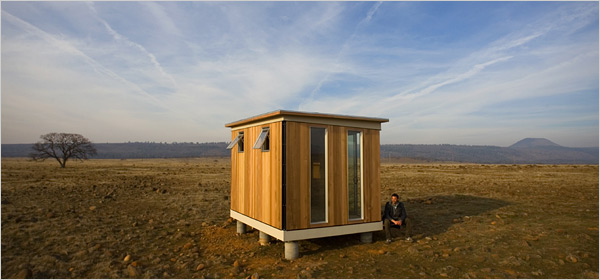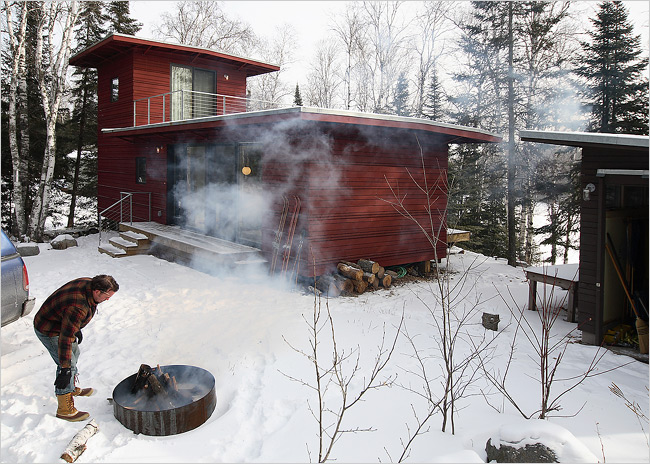 [Image: A 120-square-foot house designed by Modern Cabana; photo by Peter DaSilva for The New York Times].
[Image: A 120-square-foot house designed by Modern Cabana; photo by Peter DaSilva for The New York Times].
Today, the New York Times points our attention to the rise of small architectural structures – something surely any long-term reader of Inhabitat knew about years ago.
In any case, the article claims, there is now a “wave of interest in such small dwellings,” chosen in lieu of, say, a brand new McMansion full of closets you never enter and weird nightmares about sports equipment you bought ten years ago but never used.
“Seldom measuring much more than 500 square feet,” the Times continues, these micro-houses “offer sharp contrasts to the rambling houses that are commonplace as second homes.” For instance, we learn that to “compensate for the lack of interior space,” some clients now “cook, entertain and, for the most part, live outdoors.”
Most importantly, though:
Minimal square footage means reduced maintenance costs, less upkeep and reduced energy consumption. Prefabricated and pre-built models can require little or no site preparation, which means no anxious weekend drives to the country to make sure construction is moving along. Add to this an element of instant gratification (once the planning stage is over, most houses go up in days, even hours, and many are delivered, turn-key, to the site).
Choosing a house starts to resemble buying a car.
“In theory,” we’re told, “this could contribute to an increase in sales of undeveloped land.” But is that really such a good thing? It depends on what form your “undeveloped land” takes. Is it virgin forest?
Or a Home Depot parking lot?
Or your own backyard?
 [Image: “Scott and Lisa McGlasson’s 700-square-foot weeHouse from Alchemy Architects in northern Minnesota.” Photo by T.C. Worley for The New York Times].
[Image: “Scott and Lisa McGlasson’s 700-square-foot weeHouse from Alchemy Architects in northern Minnesota.” Photo by T.C. Worley for The New York Times].
While reading all this, however, I was reminded of an ongoing theme in medieval – for lack of a better word – Japanese poetry, where the poet’s own cloistered 10×10 living space becomes a recurring sign and reference in the poetry itself.
Typically, I can’t find a single example of what I’m talking about – but scouring my old notebooks here, I have found some poems that are so good, and topically relevant, that I thought I’d just type them out anyway.
So: some poems, inspired by small living spaces.
Sorry!
“It’s snowed!” I see,
opening up the shutters
to the light of dawn –
when, from next door, comes the sound
of a neighbor doing the same thing. —Reizei Tamesmasa
Just biding my time
night after long autumn night,
I have watched the moon –
with not a thing else to do
but sit here and grow old. —Nijo Tamesada
In this mountain village
where I’ve given up
all hope of visitors,
how drab life would be
without my loneliness —Saigyo
I remember when I was young
reading alone in the empty hall,
again and again refilling the lamp with oil,
never minding then how long the winter night was —Ryokan
Clear icy water
races straight down the mountain
and into my tub —Issa
Between window screens,
a tiny hand reaches out
to touch the spring rain —Torai
If I can find
nowhere fit to live,
then let me live nowhere –
in this hut of sticks
as flimsy as the world itself. —Saigyo
Unfortunately, when I moved out to LA I didn’t bring along my copies of Flowing Traces and The Karma of Words – so I can’t offer you much more; but each of those books contains at least one essay about the poetry and symbolism of the 10×10 room, and the literary form that “living small” eventually fostered. Of course, if you’ve read one of them, or have some quotations I could use, let me know…
Meanwhile, the New York Times writes, the actual cost of these “tiny houses” depends on what you want. Prices vary according to things like “degrees of finishing, who does the building, types of materials and design options. In general,” we’re advised, “count on spending anywhere from $35 a square foot for a very basic structure to more than $200 a square foot for designer models built with specialized or luxury materials.”
But then it’s yours: you own it. A place to sit and count fireflies and be alone with a window and a floor – until your friends come by and drink all your wine and put Scorn records on till the police show up. Even if you live in the middle of a desert, with a skylight, and 20 acres, and the stars.
Blending with the wind,
Snow falls;
Blending with the snow,
The wind blows.
By the hearth
I stretch out my legs,
Idling my time away
Confined in this hut.
Counting the days,
I find that February, too,
Has come and gone
Like a dream.
By the zen monk Ryokan.
I got the japanese poetry bug from Reginald Blythe’s translations of haiku many decades ago (and I have always found it sad the way haiku have been both vulgarised and satirised in the west). Of course it’s trite to observe that huts/sheds/shacks are architectural haiku but I share the small house obsession, have had it for a few years now.
I suspect the growing popularity is simply a sort of cultural self correcting mechanism, that after excess one yearns for sermons and soda water as Byron would have it.
I suggest this may be an answer to the impending housing crisis for young people in Scotland (UK)! House prices outsttripping wages and the offer of 100 year mortgages just to get on the property ladder – not good…
poetically in the immortal sketch by Billy Connelly relating to post-war tenament housing of Glasgow:-
“…hey Ma, Jimmy’s got his leg doon the sleeve o’ the eiderdown…”
…a comment on families of 14 in a two-bed flat with an outside toilet shared by three other families…
Thanks for the poems. And thanks for the dream of one of these small houses. I have a long-term jones to buy a tiny trailer and live in Northern Utah near a herd of wild horses I know…
Nice poem, Ian. I do hope there’s more to do in a little house than listen to sermons and drink soda water… but I understand the inversion. For what it’s worth, by the way, Saigyo’s Poems of a Mountain Home, tr. by Burton Watson, is a great book, if you’re in the Japanese poetry market.
Meanwhile, waterproof these suckers and they could work in Scotland any day.
And let me know, Prof. Estevez, if that dream becomes reality…
Funnily enough, I felt I had more space in a rented room in a shared house than I do in my current one-bed flat. Partly to do with having more control over how I arranged the space, and partly to do with the amount of shared space. Will a movement towards smaller dwellings (presumably not all by themselves in a forest!) mean that there will be a connected interest in sharing spaces such as laundries, gardens?
Great post (love the abrupt humor of Issa’s poem!), something about it gives me so much hope. Dreams of living simply, drinking wine with a good friend, and playing music for each other.
Here’s a poem by Ryokan I scribbled in my notepad last week…
My hut sits on a lonely peak
But my body is free as a drifting cloud
A riverbank village, a lovely moonlit night
Walking alone, I knock gently at your gate
Here, one is from the affairs of the world
In the center of the room, steam from a teapot rises heavily through the air
Together we let the long autumn evening trim and trim the candle’s wick beneath the southern window
Well I did mean that the huts were architectural sermons and architectural soda water. I’m inclined to think mulled wine is the drink of choice in a hut.
Oh my god, you are
The first guy to mention Scorn
In the last ten years
The first guy to mention Scorn
In the last ten years
Is that a good or a bad thing…?